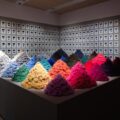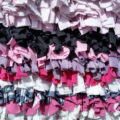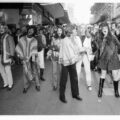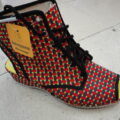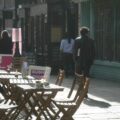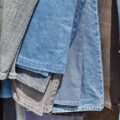Recycled Vintage Clothing Online North London
December 2, 2023Drop your clothing off for recycled vintage clothing online North London to be made into new things or pick up new garments made from recycled materials.
Clothing is recycled in several ways. Basically it comes down to re-making the garment, re-using the cloth from the garment for a new item of clothing, or breaking the cloth of the garment down into fibres or its chemical constituents and re-making the cloth, then re-making the clothes.
There are some designers who re-make clothing using existing pieces. The alterations come in the form of making baggy t-shirts into crop tops or something more fitted., which they sell alongside sell vintage clothing. Or they turn vintage dresses into skirts. These are also alterations which you can easily do at home, too. Generally you don’t even have to hem the new clothing if you don’t feel like it, since jersey which t-shirts are made from doesn’t fray and denim which jeans are made from looks good when it frays. But you can also spend half an hour or so finishing them more neatly. It’s pretty easy. Look at shops in Brick Lane, Covent Garden, or other Vintage designer or Vintage shop in West London for this.
Recycled vintage clothing online North London
So, that’s re-making. Re-using is when companies separate the parts of the donated clothing into bits of fabric again. This is very commonly done with denim. The reason is that denim is ubiquitous. Almost everyone has bought a pair of jeans at some time in their life, right? And it’s rare for them to worn to rags before they go to the charity shop. So, there is a lot of denim around. Specifically blue denim. So a new garment can be made out of blue denim, and even if it were made from two old pairs of jeans that were slightly different shades of blue, the fabric still would be similar enough that the effect would look intentional.
It wouldn’t look crisp and new, it would look a bit hippyish. But this is a way of wearing your eco-credentials on your sleeve. Something that looks obviously recycled yet cool is a conversation starter. That’s re-using post-consumer waste – the waste that is left over after you, the consumer, has finished with your clothes. The clothes are worn and washed.
Recycled vintage clothing online North London – Companies Using Discarded Fabric
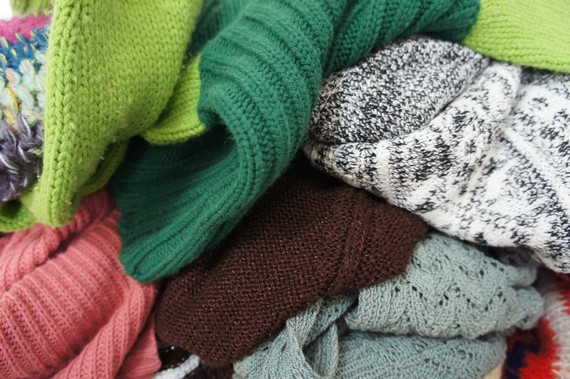
Post-consumer-fabric.
Ellen Sillekens, CC BY-SA 4.0 <https://creativecommons.org/licenses/by-sa/4.0>, via Wikimedia Commons
Another method of re-using is getting discarded fabric from factories. This is virgin, never used or worn fabric – pre-consumer waste. When factories make clothing, there is a lot of waste from offcuts and end of bolts. They buy many metres of fabric from the wholesalers – but they cannot pick the exact amount of metres they buy. A bit like if you’re making a recipe at home, and it calls for 400 grams of flour. You can’t usually buy a bag of flour that is 400g, you have to buy 500g or a kilo. The rest you will use another time.
Well, the manufacturers must buy a whole roll of fabric that is 90 metres long. They may only want to use 70 or 80 metres. The rest just stays in the warehouse, because next time a garment is designed, the designer has chosen a whole new colour way and they don’t want that fabric any more.
Patience and Care
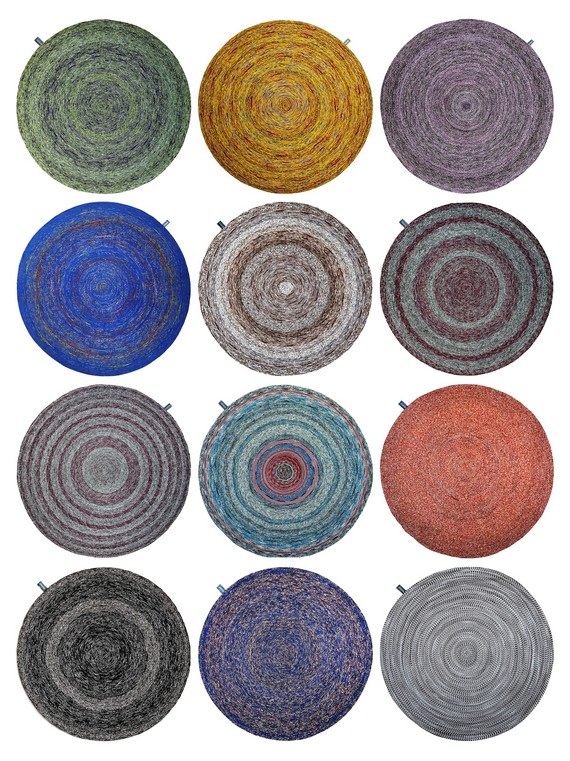
Vlisco Recycled Carpets an Wallhangings.
Simone Post, CC BY-SA 4.0 <https://creativecommons.org/licenses/by-sa/4.0>, via Wikimedia Commons
Smaller companies can buy these roll ends, because there is usually plenty to make several garments from if you’re more patient than the big manufacturers and only want to make small runs. They can also buy the smaller offcuts that come from the bits left over when the fabric is cut out. Garments made from pre-consumer waste tend to look indistinguishable from other new garments. But there is a lot of effort in sourcing and planning things made from the left over fabric, so don’t expect it to be cheap.
It is far easier to buy massive amounts of fabric, cut it out the easiest way, paying no attention to wastage, and create hundreds of identical pair of jeans in a country with low wages than it is to carefully choose fabric, bring it home and decide the best way to lay your pattern to maximise the fabric you’ve got. That is time and energy and human loving care.
Recycled vintage clothing online North London – Re-Making Cloth
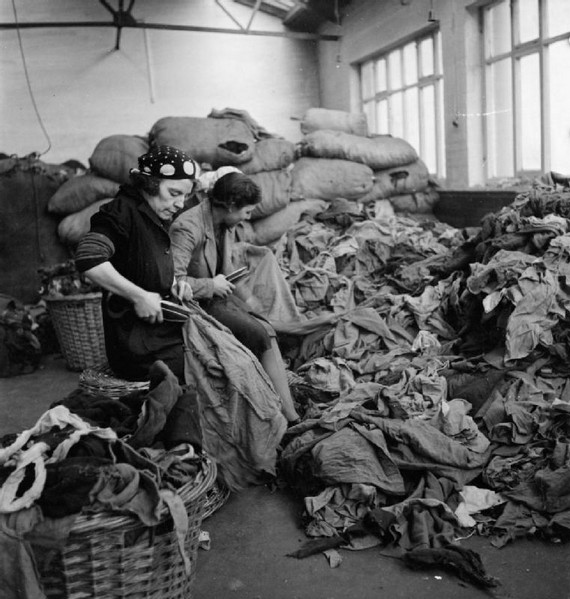
Old Rags Into New Cloth- Salvage in Britain, April 1942
Richard Stone, Public domain, via Wikimedia Commons
Now, another way to recycle fabric is to re-make the cloth entirely. There are quite a lot of ways of doing this, and companies are innovating all the time. If it is a natural fabric, it can be sorted into fabric types and then shredded, using a machine that’s a bit like a wood chipper. You just remove all the metal rivets, zips and leather patches and drop in your pair of jeans. As it passes through finer and finer blades it comes out the end as a pile of fluff. The fluff is a little like the cotton fluff from the plant that it started life as, albeit blue.
Of course, it’s only blue if the new fibre came from jeans, but that’s usually the case since, see my point above, there’s so many jeans in the world. The other common process is not to sort the different type of fabric at all, and just drop it all in willy-nilly. This produces the same colour as when you mix every colour in the paint palette together – did you do that when you were a kid? Hoping for a marvellous miracle, but instead getting sludgy green-brown. But that can’t be used for clothing as it’s too uneven. Instead it goes into rough blankets or insulation.
For that you don’t have to do too much with the fluff but press and bind it into thick felt. For new jeans, the blue fluff is re-spun into thread and then re-woven into denim fabric, which is then re-dyed an even colour. Your recycled vintage clothing online North London comes out looking like new.
Man-Made Re-Made
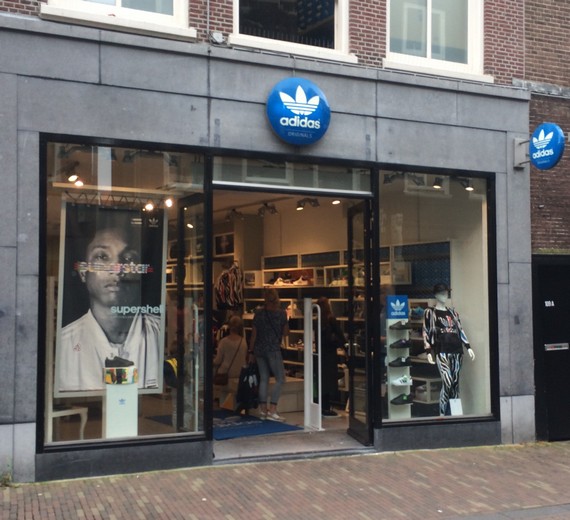
Adidas Shop
Jan Hagelskamp1, CC BY 4.0 <https://creativecommons.org/licenses/by/4.0>, via Wikimedia Commons
Man-made fabrics need a different process. However, trainer companies, like Adidas, have been putting a lot of research into how to make their products more recyclable. So many sneakers are thrown away each year, and because they are usually made from different components, all bonded together, it’s difficult to separate all the bits out for recycling. Jeans are just mostly fabric and thread, and it’s easy to remove the metal bits. But shoes are small and fiddly, and if you look at a high-tech running shoe, even just the tongue – there’s a mesh liner, a padded foam inner, an outer layer plus a branded label, each made from different type of plastic. And they are often glued, not sewn together.
So brands have started to look at how they can make a sneaker which is designed from the very beginning to be recycled at the end of its life. Adidas have pioneered a closed loop creation process, which involves shoes being made of just one type of plastic – recyclable TPU. The upper is knitted and the sole rigid, but it’s all one type of material. When you have finished with it and returned it, the shoe is washed. Then it is thrown into a grinding machine, and the resulting pellets melted. They are then stretched back into threads to be spun into yarn which can be re-knitted.
So although it sometimes feels like fast fashion is overwhelming, it is well worth engaging in the process. We can continue to do what we can and manufacturers will listen. Recycle, re-use, wear for longer, pass it on, buy vintage items, buy second hand, patronise charity shops. That’s quite an unwieldy slogan but essentially: do everything you can.



